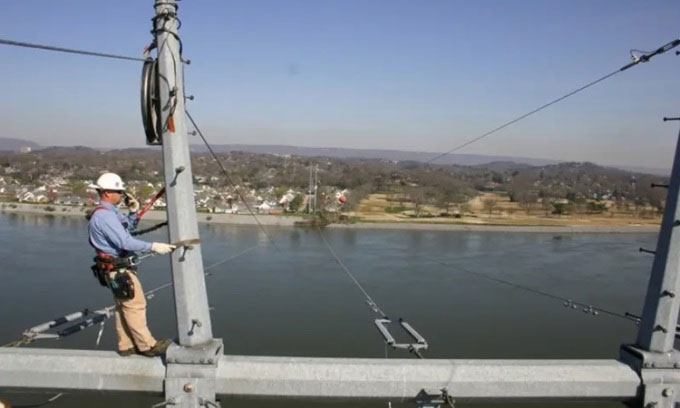Smart grid prevents power outages
Chattanooga, Tennessee, has one of the most advanced power grids in the US, able to self-repair and restore power within seconds.
Local electric utility EPB of Chattanooga spent $280 million to revamp its electrical system with smart technology. In the first 10 years, the project generated economic value of 2.7 billion USD, according to research funded by EPB. This type of smart grid provides efficient , safe, and cleaner power in the future with low bills and few outages, Business Insider reported.

EPB workers install fiber optic cable on the surface of the Tennessee River. (Photo: EPB of Chattanooga).
In most places, energy starts from a giant thermal power plant. There, transmission lines carry electricity to a substation to reduce the voltage and feed it into distribution lines to homes and businesses. Due to the effects of climate change, increasing extreme weather events are destroying electrical infrastructure, causing blackouts that cost US businesses an estimated $150 billion a year, according to Ministry of Energy of this country.
Meanwhile, countermeasures also create their own pressure on the power grid. Wind farms and solar panels feed electricity into the system intermittently, so it is difficult for the supply to meet electricity demand that fluctuates throughout the day. Renewable energy also complicates matters. From 12,000 power plants, in just a few decades, the US may need electricity from a million scattered sources such as hydroelectric dams and rooftop solar panels.
To solve the problem, the power grid needs to be upgraded with smart technology, according to Kevin Schneider, chief power systems research engineer at the Pacific Northwest National Laboratory. An important task of every power grid is to balance supply and demand. Too much electricity can destroy the system while not enough electricity will leave many people without access. Smart grids automatically balance using a system of meters, sensors, controllers and computers.
Initially, EPB of Chattanooga needed a way to communicate with all smart devices to be able to make important updates to their systems, according to David Wade, executive director of EPB of Chattanooga. That is using fiber optic cable. The EPB board of directors approved the plan in 2008. With a budget of $169 million, workers began digging trenches and installing fiber optic cables throughout Hamilton County. According to the plan, the project will last 10 years, but a $111.5 million grant from the US Department of Energy helps speed up the pace, reducing the completion time by half. EPB completed construction of the smart grid in 2012.
In just 4 years, EPB has installed fiber optic networks and connected more than 180 smart meters in homes and businesses. The company also installed about 1,200 smart switches, which can open or close electrical current according to software or remote commands from the operator. These devices can quickly change transmission lines, bypassing damaged power lines to avoid power outages. That means the system can self-heal and restore power supply within seconds.
As a result, EPB recorded a 55% reduction in annual outage minutes, equivalent to 19 million minutes. Previously, operators had to drive to each switch to manually open and close it. Over the next decade, EPB will spend an additional $115.5 million to expand the smart grid.
- ITU adopts smart grid standards
- Exploding the micro grid market
- Smart grid development project in Ireland
- A great solution of $ 6 helps to bring electricity to millions of poor people
- Grid connected solar power in Ho Chi Minh City
- America is so dependent on solar energy that they start to fear eclipse
- Video: The total solar eclipse may cause widespread power outages in the United States
- Grid using wind power
- Many states in the US are severely affected by snowstorms
- Light up with solar power technology
- The power plant flies in the air to inspire energy
- New Project Investigation Tool
 The US company is about to build a supersonic passenger plane of 6,000km / h
The US company is about to build a supersonic passenger plane of 6,000km / h Japan develops avatar robot as in fiction film
Japan develops avatar robot as in fiction film Australia tested the world's first mango picking robot
Australia tested the world's first mango picking robot America develops technology to separate water from animal waste
America develops technology to separate water from animal waste